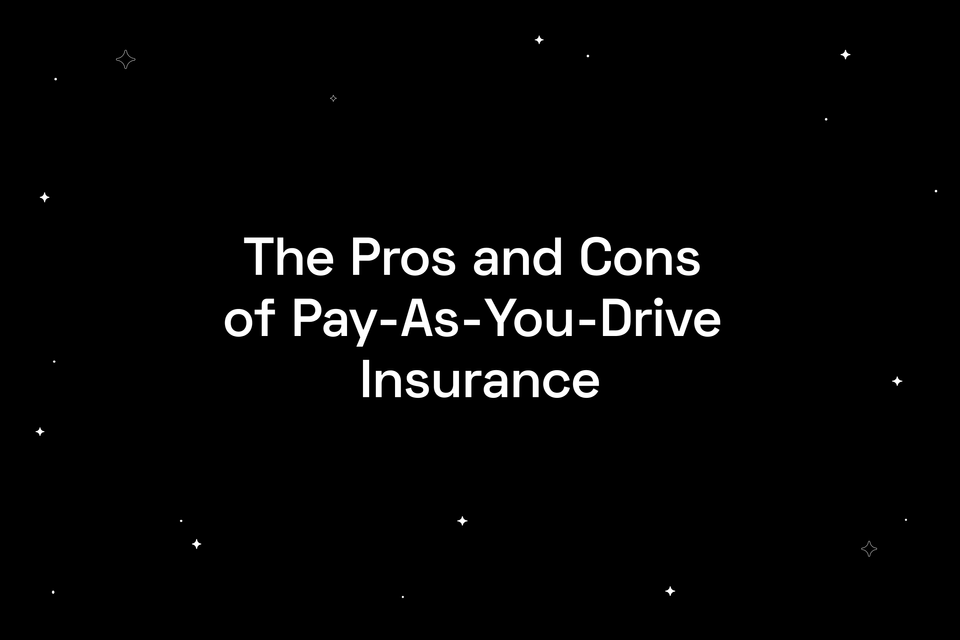The Pros and Cons of Pay-As-You-Drive Insurance


As the world becomes increasingly environmentally conscious and insurance companies look for innovative ways to offer cheaper policies, Pay-As-You-Drive (PAYD) insurance is becoming more popular. Pay-As-You-Drive, also known as Usage-Based Insurance (UBI), is a type of car insurance that allows you to pay for your coverage based on how much you drive. This differs from traditional insurance models, as premiums are based on factors such as your age, gender, and driving history. With Pay-As-You-Drive, telematics devices are used to track your driving habits and determine your premium. While this new model offers the potential for car insurance savings and flexible premium payments, there are also drawbacks to consider. As we delve into the pros and cons of Pay-As-You-Drive insurance, it's worth noting that a recent report by P&S Intelligence predicts that the global Pay-As-You-Drive insurance market will reach $36.4 billion by 2025- highlighting its increasing popularity among drivers.
What is Pay-As-You-Drive Insurance?

As car insurance becomes a mandatory expense for all drivers, it's no surprise that alternatives to the traditional insurance model have emerged in recent years. One such model is Pay-As-You-Drive (PAYD) insurance, also known as usage-based insurance. Unlike traditional car insurance, PAYD differs in that it calculates premiums based on the actual amount driven, rather than a preset flat rate. While PAYD offers the potential for car insurance savings and more flexible premium payments, it's important to weigh the pros and cons of this model. Proponents tout the telematics used to track driving behavior and potential discounts for low-mileage drivers, but others argue that privacy concerns and potential penalties for those who drive more than expected may outweigh the benefits. Regardless, PAYD insurance is gaining in popularity, with a recent survey finding that 75% of drivers would be open to trying it out.
Pros of Pay-As-You-Drive Insurance

PAYD insurance allows for lower premiums for drivers who do not use their vehicle frequently, making it a cost-effective option for those who live in urban areas or take public transportation. Not only does PAYD save you money, but it also encourages safe driving habits. With usage-based insurance, drivers are rewarded for driving cautiously and within speed limits. Additionally, PAYD insurance offers flexible premiums that are based on actual vehicle use, giving drivers greater control over their car insurance savings. By incorporating LUNA, drivers can take advantage of telematics technology to determine if PAYD is a cost-effective option for their individual driving patterns. With LUNA's assistance, PAYD insurance can be easily tailored to your specific needs, saving you both time and money. So, if you are looking for a convenient and cost-effective way to insure your vehicle, consider the benefits of Pay-As-You-Drive insurance, and make sure to incorporate LUNA for the ultimate insurance experience.
Cons of Pay-As-You-Drive Insurance

As usage-based insurance programs continue to gain popularity, it is crucial to consider the potential limitations of Pay-As-You-Drive (PAYD) Insurance. While PAYD offers benefits such as personalized premiums based on actual driving behavior, there are certain aspects that require careful thought.option.
One important factor to consider is the issue of privacy concerns surrounding the collection of telematics data. With PAYD, insurers gather information about your driving habits, which some individuals may find intrusive. It is essential to evaluate the trade-off between personalized pricing and the potential compromise of privacy.
Additionally, it is worth noting that certain driving styles may result in higher premiums with PAYD. Aggressive driving behaviors or frequent hard braking may lead to increased costs. It is important to be aware of how your driving habits may impact your insurance premiums under this type of policy.
Furthermore, it is crucial to recognize that PAYD insurance may have limitations when it comes to coverage flexibility. Depending on the specific insurance provider, there may be gaps in policies that could leave you underinsured in certain situations. It is essential to carefully review the terms and conditions of the policy to ensure it aligns with your specific coverage needs.
Comparing PAYD to Traditional Insurance Models

The main advantage of PAYD insurance is that it can offer significant cost savings compared to traditional insurance models, as well as more flexibility in premium payments. However, it may not be the best choice in all scenarios. Traditional insurance might be more beneficial in situations where you are using your car for business purposes or if you drive a lot, as PAYD typically has mileage limits and can become more expensive if you exceed them.
It's important to take the time to understand your individual insurance needs and evaluate your personal driving habits before deciding on a policy. By doing so, you can select the insurance model that offers the best coverage and savings for you.
Impact of PAYD on Insurance Industry

Pay-As-You-Drive Insurance, or PAYD, has had a tremendous impact on the insurance industry. As a result of this innovative solution, many insurance providers have been transforming their products to lean towards usage-based insurance. In essence, drivers only pay for their insurance based on how much they drive, and how they drive. This technology is helping insurers to offer more flexible premiums, save motorists money on car insurance, and provide them with additional decision-making power when it comes to choosing the right plan for them.
Telematics, a technology that tracks a vehicle's location, speed, and other metrics, is the key enabling technology that makes PAYD work. Car insurers are advancing the technology by leveraging things such as smartphone apps and in-car devices to capture accurate driving data from their clients.
With contemporary and forward-thinking digital innovation strategies emerging every day, we can predict more trends in the car insurance space for PAYD technology. Ultimately, broadened adoption of PAYD will make it a commonplace in our lives, allowing an even wider range of individuals to take advantage of its many benefits.
How to Decide if PAYD is Right for You

Making decisions about insurance policies can sometimes seem daunting. However, with Pay-As-You-Drive insurance, making the right decision depends on your driving patterns and lifestyle. Before deciding to dive in, you can assess Pay-
As-You-Drive's suitability with a checklist or questions to weigh the pros and cons. It is essential to analyze your driving patterns and lifestyle, including your daily use of your vehicle. Telematics offer the flexibility to pay for the distance you cover, making it easy to budget your expenses.
At LUNA Insurance, we understand that every customer is unique with different insurance needs. Our expertise and personalized service make us a reliable source of information in helping you decide if Pay-As-You-Drive aligns with your needs. With LUNA, you have access to a team of licensed professionals available round-the-clock to provide personalized consultations and answer any questions.
Our innovative app offers real-time tracking, easy policy management, and hassle-free transitions, making LUNA your one-stop-shop to meet all your insurance needs. Our service-tech first insurance brokerage offers quotes from top carriers, ensuring fair pricing and proper coverage. With LUNA, you can get insurance quotes in two minutes, and our users save an average of $597/year on auto insurance.
Conclusion
At LUNA understands the importance of choosing the right insurance model that matches individual lifestyles and needs. Pay-As-You-Drive Insurance (PAYD) or Usage-Based Insurance (UBI) can be a great option for those who have flexible driving habits.
PAYD insurance is a type of telematics-based insurance that utilizes a car's computer system, or a small device plugged into the car, to monitor the driver's driving habits. This insurance model calculates premiums based on the distance driven and the driving patterns observed by the device or system. The benefits of PAYD insurance include flexible premiums and potential car insurance savings.
However, it is essential to weigh its drawbacks against its benefits before purchasing. As a service-tech first insurance brokerage, LUNA encourages its users to make an informed decision when choosing insurance models. It provides expert access, privacy protection, and 24/7 agent availability, making comparisons easy and hassle-free for its users. Consult with LUNA or explore other options, but be sure to find the best insurance solution that works for you.
